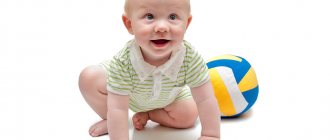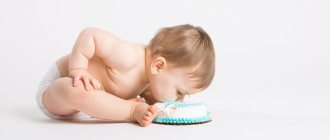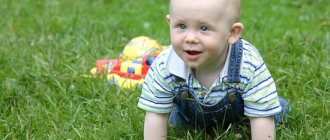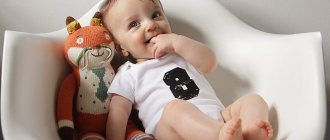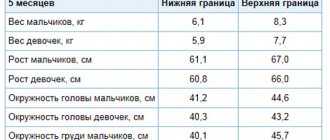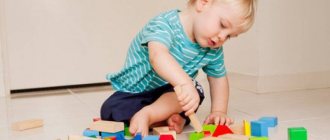At this age, the baby already knows how to sit, actively explores the world and takes his first hesitant steps. The physical development of the child at this time already somewhat reduces its intensity. Work begins on the accuracy of movements. The little one begins to actively explore the world around him, taking things that he could not reach before. Moves quite quickly on all fours. Therefore, it should not be left unattended.
At 10 months, the baby independently eats many products from the “adult” kitchen: a peeled apple, a pear, is able to chew a bun or children’s cookies, many babies master the spoon. The baby eats 5 times a day, but gains less weight than before.
The table below shows the average performance of a child at 10 months.
| Index | Average value | Boys | Girls |
| Weight, g | 8500—9200 | 7400—11 400 | 6700—10 900 |
| Height, cm | 71,5—73,3 | 68,7—77,9 | 66,5—76,4 |
| Head circumference, cm | 44,2—45,4 | 42,9—47,9 | 41,5—46,9 |
| Chest circumference, cm | 47,2—47,9 | 45,1—51,4 | 45,2—50,1 |
What does a baby look like at 10 months?
During this age period, the baby already has an expressive and understanding look, her hair grows, her legs straighten.
Behind the child’s dazzling smile you can see several small white teeth. He already has good control of his body, can actively move and play. At this stage of life, the child is very inquisitive and absorbs all information like a sponge.
Read more about Teething in children: timing, symptoms, how to help your baby?
How to properly brush your child's teeth?
What games can you play with your child?
Parents often wonder how to develop a child through games? There are lots of ways to do this. Here are the simplest ones:
- "Round dance". Take the child by the arms and perform circular movements, imitating a round dance. You can hum funny songs or read poems. This game develops body coordination and teaches the child to perform simple movements.
- "Throwing toys." You need to put an empty box on the floor and throw toys into it with the child from a certain distance. This is how the manipulation of an object develops.
- “Passage through a tunnel.” You need to construct a tunnel from empty boxes and call the baby from the other side. As he crawls through it, he will see how the distance and objects change.
What can a 10 month old baby do?
10 months for a baby is a small anniversary that opens up new opportunities and skills for him. He becomes a full-fledged member of society and strives every day to learn about the world around him.
At this age, babies recognize their parents and grandparents not only by appearance, but also by sound. That is, upon hearing a familiar voice, he strives to attract attention to himself with sounds or actions. He actively smiles and laughs at his family and can even utter some sounds. For example, “ma”, “pa”, “ba” or “bang”, “bang”.
He greets his loved ones with great joy, stretching out his little hands to meet them.
Main indicators of physical development
By 10 months, the babies had significantly increased in height and weight compared to the newborn period, but monthly gains decreased. This is due to the baby's increased activity and energy expenditure on motor skills.
9 months baby
Physical indicators of girls 10 months
| Indicators | Weight, kg | Height, cm | Head circumference, cm | Chest circumference, cm |
| Girls 10 months | 6,7-10,9 | 66,5-76,4 | 41,5-46,9 | 45,2-50,1 |
Physical indicators of boys 10 months
| Indicators | Weight, kg | Height, cm | Head circumference, cm | Chest circumference, cm |
| Boys 10 months | 7,4-11,4 | 68,7-77,9 | 42,9-47,9 | 45,1-51,4 |
The average size of a large fontanel is 12-14 mm. The number of milk teeth is 6-8.
Attention! Deviation in the timing of teething from the norm by six months, as well as teething in any order are absolutely normal phenomena. Medicines that can influence the timing and sequence of teething do not exist in nature, says pediatrician E. Komarovsky.
Physical indicators
Toys for baby
It is very important for parents to remember that toys for a child are necessary for his full development. Therefore, you should constantly replenish the children's basket with all sorts of bright favorites. In addition, all toys and games must be age appropriate. You also need to approach the choice of children's toys very responsibly. All items must be made only from high-quality and non-toxic materials.
In order for the baby to develop and receive only positive and vivid impressions, the children's basket should contain the following toys;
- Toys made of soft materials. These can be various animals or cartoon characters;
- Wooden games. At the moment, the market offers a wide range of children's educational and safe games;
- Musical toys. Xylophone, piano, drum.
It is also recommended to give your baby toys made of various materials. The baby gets to know the world with the help of his little fingers. Soft, rustling, ribbed materials are welcome.
List of toys for children by age
Emotional and social abilities
In this development, the baby also undergoes changes. Here's what you can already observe:
- The child learned to convey his feelings through babbling, rather than tears and screams.
- I began to understand the words of prohibitions. And maybe out of spite the mother does bad things, the baby even enjoys being scolded. Although some children still get offended and upset.
- He makes funny sounds and laughs at them himself.
- He gets upset to the point of tears if they start taking away his favorite toy or force him to do something he doesn’t want.
- He already knows how to ask to go to the toilet (to use the potty).
- He loves when he is given the right to choose.
My son, for example, really loved it when I allowed him to choose the book that we would read.
- Loves to play, both with himself and with other kids.
Development of the musculoskeletal system
During this age period, the little fidget actively gets to know his body and learns to use it.
Movements become more confident and conscious. The baby can already crawl freely and rise to his feet with the help of nearby objects: a sofa, a crib.
The baby can already stand on his feet for a long time while bending forward and back. Some begin to walk independently, while others move around holding their mother’s hand.
Children are no longer interested in sitting in one place. They like to overcome various obstacles and conquer them. During this period, parents should take care of purchasing the right and high-quality shoes. Children's legs are just developing, so shoes should have arch support and support the legs well.
At home, it will be useful for your child to walk barefoot or wear non-slip socks. In this case, the baby will feel the surfaces on which he walks and study them. For example, a soft carpet or smooth floor. All this greatly influences his development.
Motor activity of a toddler
At ten months, the baby already has the following skills:
- He takes small objects with his thumb and forefinger, makes pyramids, presses small buttons.
- Throws things out of closets and cribs.
- Sits independently. Can sit down, both from a standing and lying position.
- Crawling confidently. Don't be discouraged if your baby doesn't do this. My friend’s son didn’t crawl at all, and at 11 months he immediately stood up and walked.
- Can climb in and out of low beds.
- She can get up or even walk slowly, while holding on to her mother’s skirt or some piece of furniture.
- Perhaps your baby can already move around holding onto a support with only one hand, especially if the other is occupied with a toy.
Favorite games
Children at 10 months are no longer interested in sitting with toys alone. They need active movement and constant attention. The kids are throwing their toys around with interest and destroying the construction sets they have built.
The baby knows all his toys and can give them to her at his mother’s request.
At 10 months, children can throw balls or kick them with their feet, push cars, try to build a tower or assemble pyramids. Of course, the movements are not yet entirely clear, and something may not always work out, but kids are interested in learning about the world around them.
At the 10th month of life, the mother can teach the child to put his toys in a basket. For example, you can take a toy and show the baby by the hand the place where her place will be.
He is very interested in musical and interactive games.
Of course, not every child can succeed the first time, and he may get upset and cry. However, you should not immediately calm him down and do everything for him. You should explain to the baby and show how it will be better, and let him try again.
Thus, the baby will learn to overcome obstacles without difficulty and completely calmly.
It should also be noted that children in the 10th month of life are very interested in bright and colorful books. They look at the pictures with curiosity and can point out a chicken or a bird with their finger.
In addition, reading poetry and fairy tales greatly develops and delights little fidgets.
Try to read with your baby every day and this will help expand his vocabulary.
Physiology of the baby
The child has matured, become very active, and already spends much more energy. And as a result, little weight gain. Over the past month, a baby can gain only 300 grams and grow only a centimeter. On average, a ten-month-old baby weighs from 8 to 10.5 kg and has a height of 71 to 75 cm.
My son weighed 10 kg 400 grams, and his height was 76.5 cm.
What changes in physiological development can already be observed in a child:
- He listens to what his parents are saying and tries to repeat the words he heard.
- Laughs when people coo and joke with him.
- He is happy when they start playing with him.
- Loves to play with a pyramid of multi-colored rings.
- Often plays with small objects. This develops the child's fine motor skills, but at the same time there is a risk that the baby will put something in his mouth, so do not leave him unattended.
- Loves to throw things and watch them fall.
- He can sit up on his own, crawls easily, and tries to walk while holding onto his mother or crib.
- Already able to chew, but only crushed food.
- Shows interest in other kids.
- Trying to take the first steps.
- Holds a cup and spoon independently.
- Able to get in and out of bed.
- Can hold two objects with one hand at the same time.
- It is very important for him to hear praise from adults, especially from his mother.
- Shows fear of strangers and panics when left in an unfamiliar place.
- Fulfills small requests from parents.
Psycho-emotional state of the baby
At 10 months, children already show their emotions well: they get upset, happy, offended, and even know how to sympathize.
The baby loves to kiss and hug with his parents and loved ones. He understands when someone is upset and can take pity and pet him.
At this age, children really like to fulfill some requests and receive approval and praise for it. Always praise and hug your baby. This helps develop confidence and self-esteem.
Don’t raise your voice if your baby doesn’t want to do something or isn’t able to do something. Such behavior will only frustrate him, and he will not comply with requests in the future.
If the child begins to be capricious for some reason, do not rush to pick him up and offer him what he wants. He already understands how to influence his parents to achieve what he wants. Try to explain to him what he can and cannot do, and whims are not a way out of the situation.
Some parents organize a real masquerade for the child so that he will respond to a request or simply eat. This is not recommended, since he simply will not react to the most ordinary things.
Also at this age, the baby already has a well-developed sense of humor. He reacts with frisky laughter to the jokes and laughter of his elders. He likes it when someone makes a face and he tries to repeat it himself.
Child plays: from birth to one year
Authors : Marilyn Segal
A CHILD'S WORLD Ten months is a very interesting age. Watching your baby is fun and pleasant. He is so selflessly immersed in the game that he almost does not notice the spectators admiring him. The ten-month-old's main concern seems to be whether one object can somehow be used to do something with another. Of course, the child asks this question with actions rather than words. While playing with two objects at the same time, the baby comes up with the idea of turning one of the objects into an instrument. Let's give the most common examples: a child takes a spoon and carefully scatters peas around his high chair or beats a tea strainer on a pan. We see that the child, in his actions, seems to separate the means and the result. An object used as a tool serves as a means for the baby, and the achieved effect serves as a result. As your child becomes interested in more complex games, you will notice that something has changed in the way you play with your baby. When the child was not even six months old, you talked to him and played games according to the scheme “I - for you, you - for me.” The baby liked games that required communication, he reacted emotionally to all your words and actions, and often laughed. At ten months, the child can already, if necessary, independently reach or reach for a toy, take it, and now, as a rule, games between parents and children are not complete without toys. The baby continues to enjoy games “with communication”, such as “hide and seek” or “there is a horned goat”, as well as “singing together”; Such games give the child a feeling of closeness and trust in his parents. However, at this age, games with new, slightly different toys come first, and the child plays with pleasure, passing a toy to someone and immediately receiving it back; this transfer from hand to hand captivates the baby. During the game, the child learns and remembers a lot of new things.
Motor skills
At ten months, differences in the development of children's motor skills are very noticeable. One child is learning to crawl well, and the other is already walking well. Despite the old adage “you have to crawl before you can stand on your feet,” this is not always the case. Some children, especially those who have peers nearby, very quickly pass the crawling stage; sometimes this happens almost unnoticed. They strive with all their might to get to their feet as quickly as possible, pulling themselves up with the help of chairs or grabbing their father’s trouser leg, and in their little-understood language they give the command to their parents to take them by the arms and lead them. In contrast to the child who insists on walking and only walking, there are children who become crawling specialists. In fact, a deftly crawling baby moves much faster and maintains balance better than a child who stands on his feet early. When exploring new territory, a skilled crawler is less likely to harm itself. A crawler, just like a child who has learned to walk, can deftly avoid obstacles, climb stairs and explore interesting objects. By observing an actively crawling child, you can see the gradual development of this skill. First, the baby crawls, alternately moving his arms and legs; then he begins to methodically move his right arm, left leg and vice versa. And then he crawls so deftly and evenly that it is almost impossible to understand how he does this; a skilled crawler can, while moving, drag some kind of toy behind him. Just like a child who has learned to walk. Interestingly, there is no direct correlation between a child's motor skills and mental abilities. If a child starts early, this does not mean that he is smarter or will solve problems well. Moreover, there is no need to rush things. Each child develops differently, and therefore he will go when he is ready for it. At ten months, most children stand on their feet. Many of them can maintain their balance quite independently. Using this advantage, the baby, leaning on something, begins to stand. In the morning you can see a child standing in his crib, leaning against the bars, shouting something with a victorious look. Later, this child may end up at the coffee table, where, leaning on the tabletop, he will give you a whole speech, raining down on you a stream of not very coherent sounds. Children take great pride in being upright. Parents often ask whether it is necessary to install a playpen for ten-month-old children. Answer: maybe. On the one hand, a ten-month-old baby explores the surrounding space and objects with interest, and confinement in a playpen will hinder his research. On the other hand, for children who have just learned to pull themselves up and stand up, the playpen can be a convenient and safe place for training. It also happens that parents cannot monitor their baby all the time, and then the number one factor becomes the safety of the child. Most often, the playpen will be useful only if you use a creative approach to it. For example, you can use a playpen with the side down, then it will be convenient for the baby to learn to climb into it, store his toys in it, or practice throwing various objects at it. As your baby reaches and grabs things, he develops coordination of the shoulder, forearm, wrist and fingers. It is useful to give him some specific tasks, for example: opening a box or putting a toy dog on his feet. If you put a small object in front of your child, he will quickly reach for it and deftly grab it with his thumb and forefinger. In the first phase of this movement, you can notice a slight tilt or turn in the child's wrist. When your child was younger, she already used a similar grasping motion to pick up crumbs in her high chair. He also turned his hand at the wrist when he held the toy and examined it from all sides. Now he has combined these two elements, and his movements have become more skillful and coordinated. The child also had a new achievement - he learned to tear paper. The baby grabs thin pages of a magazine or phone book and with a quick movement (twisting his hand at the wrist) tears the sheets. Around this time, the child may develop another interest; he will want to “build” by stacking one small cube on top of another. He needs to take the cube with his thumb and forefinger, lift it and place it on another cube. Then, of course, he will push and topple this “structure.” However, the baby will not stop there. He will want to put a third on the second cube. But as a result, the “tower” will collapse again.
Ability to see, hear, feel
An adult knows that the things we look at from afar do not get smaller. Being at the other end of the room, we can easily identify by eye a cup of the same size that is standing in front of us. This ability to take distance into account when determining the size of an object is called constancy of magnitude. Some psychologists believe that children gradually develop this ability, but it is still necessary for the child to have some training in perceiving an object. There are signs in the behavior of a ten-month-old child that indicate that he is developing the concept of the constancy of quantities. A large dog, seen for the first time, frightens the baby, even if it is on the other side of the room, but the child will want to play with a small dog that is very close to him. A ten-month-old person already has an idea of how certain things should look, demonstrating this in various ways. Give your child a cup upside down and he will immediately turn it over. If a sister does a headstand, the baby laughs looking at her. He can already recognize a familiar object if only part of it is visible to him. If the spoon is almost entirely covered with a napkin, the child, nevertheless, confidently takes it and drags it into his mouth. At this age, both the child’s auditory and visual perception continues to improve. He begins to determine where the sound is coming from. Hearing something behind his back, the baby immediately turns and looks at the place where the source of the sound should be. He can distinguish family members solely by voice and understands the mood of loved ones by slight changes in tone - anger, a desire to tease, calmness, joy, irritation - all this is quickly recognized by the baby. At nine months, the child was attracted to the emptying of boxes and purses. At ten he begins to become interested in their contents. He puts his fingers in his nose and mouth, puts rings on the shaft, hides little dolls in toy furniture. The child is very interested in the problem of what goes with what. He will work very hard trying to fit the measuring cup into the smaller one, making frustrated noises as he does so. Having failed to insert one object into another, the child may give both objects to an adult with a silent request for help. The child develops the ability to solve problems “for” or “in”. If you hold a toy in front of him, blocking it with a transparent tray, he will most likely go around the barrier to get the toy. Just recently he tried to get it through the tray. Place the toy in a transparent box with a lid and you will see a similar effect. Previously, the baby tried to get to the toy through the wall or lid of the box. Now, to get the toy, he will push the lid off and climb inside. Another activity your child may enjoy is throwing objects into a box. When the child was smaller, he already threw toys at her, but these were random movements. And then, after a few months, the child learned to purposefully throw an object into the box. Sometimes he throws a toy there only to immediately grab another. Sometimes children like to play by throwing bits of food and toys off their high chair. At ten months, the baby loves to experiment by throwing objects. He can hold a set of keys over a saucepan and then open his fingers to check how the keys jingle at the bottom of the saucepan.
We understand our child
A ten month old baby is usually friendly and sociable. He uses his babble to talk to new people and enjoys experimenting with all sorts of sound effects. At this age, the baby exhibits the ability to imitate, and he tries to copy sounds and words that are not yet in his repertoire. He already understands some words and readily demonstrates his achievements in front of a familiar audience. These new patterns, learned by the child, can manifest themselves in word-action games, such as: “Where are our eyes”, “How do you love daddy”, “Okay, okay”. At the age of six to nine months, children are attached to their parents almost in the literal sense, that is, they can hardly tolerate any separation. At ten months there may be some changes in the expression of this affection. As crawling becomes an easy, automatic task for the child and he begins to realize that he will be able to return to his original place on his own, the baby boldly leaves his mother and dares to crawl away to where she is not visible. Now he feels like an independent person who is ready to go on a hike to the other end of the room or even beyond it and explore new territories. When going on a “distant expedition”, a child can take his favorite blanket or toy with him. This toy or blanket is a kind of guarantor of security for him, helps him break old ties and gain independence. Finding himself with one of his parents in an unfamiliar house, the child cannot be calm enough, and certain changes occur in the manifestation of his curiosity. At first, he will try to limit the territory of his games to the distance where he can reach mom or dad. Even if he decides to go to the other end of the room, the baby will follow his mother with his eyes and from time to time “call” her so that the mother will give a voice. The presence of mom or dad gives the child a feeling of security, and this helps him gradually satisfy his curiosity. Some children outside their home do not dare to explore even if one of their parents is nearby. If a stranger enters the room, such a baby will cling to the parent’s leg and hold on to it until the “stranger” leaves. If mom or dad goes out for a while, leaving the child, he will react violently to the parent's return, simultaneously hugging him and expressing his indignation at his absence. For children who are very afraid of their parents leaving, we advise you to gradually accustom them to the temporary disappearance of mom or dad. You can start by playing hide and seek - hide your head under the blanket. When the child has learned the rules of this game, the next step is to hide in the room, and a moment later appear with a joyful greeting: “Hello, baby!” Hide again and reappear. When your child gets used to your disappearing and reappearing within the room, try to extend this game outside the room. Relatives, a brother or sister, or close friends can also help the child - if the baby stays at home with someone he knows, it is much easier for him to say goodbye to his parents. If parents are forced to leave their baby for a long time, it is very important to have a nanny that the child loves and trusts. The same goes for the nursery. Numerous studies on the example of nursery children show that if the child has a constant and caring nanny there, and he is loved and happy at home, the baby adapts well to the nursery regime. An alternative to a nursery can be a “home” nanny. Of course, as a rule, parents prefer to have a nanny come to their home. It is advisable that the prospective nanny can visit you once or twice and get to know the child before she has to stay with him. If your circumstances require you to leave your child at a childminder's home, it is important to make the situation easier for him. A favorite toy that the baby will take with him or a blanket can help here. It’s good if you spend some time with this nanny and your child. He won't be so scared if he sees that mom and nanny communicate well and cheerfully. A ten-month-old child at home already has a good idea of what awaits him during the day. In a new environment, he cannot predict events and does not feel so confident. If you haven't had to leave your child often before, he will most likely be afraid of the nursery or nanny. Being confident that you are leaving your baby with an experienced nanny who will treat and play with him well, say goodbye to your child cheerfully and decisively so that he does not have time to pity you. Even if a child behaves quite independently during the day, at night he needs his parents to be nearby. Having discovered that the parents are not there, the baby will stand upright in the crib and will never lie down until they are found. The problem of how to prepare a child for bed is solved by different parents depending on their concepts and capabilities. Some people hold the baby until he falls asleep and then put him in the crib. Others prefer to rely on the usual ritual: giving the baby a favorite soft toy. Sometimes the mother sings a lullaby, or the child is caressed and kissed until he begins to fall asleep, and only then the parents leave the baby. And yet, some parents do not want to accustom their baby to something from which it will be difficult to wean him later. They cheerfully but firmly put the baby in bed and say goodbye, not paying attention to his crying. There is no single correct solution to solve this recurring problem. Every family should look for the option that works best for their child.
ACTIVITIES WITH A CHILD
Practical advice
A ten month old baby needs variety. Even if he has a lot of different interesting activities and toys at home, the child still needs to spend some time outside the home. A trip in the car, visiting a store, visiting a relative or a playmate are extremely important not only for the mother, but also for the child. By this age, children's games become more and more meaningful and "organized", so it is good if mom and dad can specifically set aside some time for playing with the baby. It is very important that the father works with the baby, since fathers and mothers usually have different styles of play. Dads make more noise and contribute to the physical development of the child, and mothers pay special attention to intellectual education. Both games are important for a child.
Game time
New discoveries Talking through a tube Talk to your child through a cardboard tube, trying to change your voice. You will be surprised at how attentively your child will listen to you, then have some fun by saying some sounds into the phone: ba-ba-ba or ma-ma-ma! Give the phone to the baby. He may want to repeat these sounds. Baby cubes Make several red cardboard cubes and one yellow one (250g milk cartons lined with sticky paper work well for this purpose). Place a bell in the yellow cube. See if the child, looking for a cube with a bell, can distinguish it by color. Box with holes Children love to stick their fingers into small holes, and you can create a “toy” that your baby will like. Take a small box with thin walls and make two finger-width holes on both sides. From the inside, cover the walls of the box with different materials - fur, burlap, velvet or sandpaper. Show your child how to put his finger in the hole. (And you can put your finger in the other hole.) Talk to your baby about how his finger feels when touching the walls of the box; is it soft and pleasant there, or is the wall rough and hard, etc. You can even play with such a box in the car. Search and find Hide a watch or a small radio under your pillow. The child will look for the clock, listening to where it is ticking. Such experiences will improve his listening skills. Time for some music Take a cereal box and turn it into a baby drum. Give your child a wooden spoon as a stick and show him how to hit the box with it. Pushing the Car Show your child how to push a small car or truck so it moves across the floor. After some time, the baby will learn to push the car so much that it will roll on its own for a long time. Slamming the table If you have someone the same age as your child visiting, sit them both at the table and let them play by banging and slapping the table. Play with the phone Take a toy phone and “talk” to your child, and then let him talk. By playing “telephone”, the baby will begin to enjoy the conversation. It's even better to turn off your real phone and play with it, although this may have its inconveniences. The child may want to play again when the phone is not turned off. Let's tear it to pieces Some children at ten months are already trying to tear something apart. Old magazines, tissue paper, wrapping paper or foil give your baby something to experiment with. Just remember that your child may want to try what the paper tastes like. Children's experiments in receiving small pieces of paper require close observation. If you see that your baby is more interested in stuffing a piece of paper into his mouth than tearing it, it is better to postpone these activities to a later date. Development of coordination Sticks and pebbles During a walk you can find a lot of different objects for activities with children. Show your child how to collect pebbles, twigs or leaves into a pile. This will not only help improve the child’s motor activity, but also stimulate the development of the sense of touch. Pulling a Paper Strip from a Table Cut a piece of sticky paper into strips and attach one end of the strips to the table. Start pulling off one strip - the child will quickly understand what to do. For him, this will be as much fun as peeling stickers off jars and bottles. “Do as I do” At this age, the child imitates with pleasure. Play “do as I do” with him - let him repeat your hand movements and simple gestures. Knock on the table, clench and unclench your fist, or put a hat on your head, all the while explaining to your baby what you are doing. Balance on an inflatable ring Place a children's inflatable ring in front of your child, give him a few small cubes and show him how to place them in a row on the surface of the circle. Feeling the instability of this surface, the child will more acutely understand what balance is. This activity will help improve the coordination of his movements. An inflatable circle is also useful for the bathroom - the child can throw objects into the center of the circle; children usually like this game so much that it can last for a very long time. You need to reach the toy. If your child is already pulling himself up, trying to stand on his feet, you can give him a task. Place your baby's favorite toys on a low table where he can reach them. By retrieving objects, he trains spatial orientation. Toy with a rod Take a cardboard tube from a toilet paper roll. Punch a large round hole in a plastic coffee can lid and show your child how to put the plas on the straw. Three times a hero If your child has a toy in each hand, try giving him a third toy and see if he can figure out how to hold all three. New solutions What objects can be folded into one another By experimenting with various objects, the baby little by little begins to understand what a quantity is. A good example would be cups of different sizes. Take two cups and show your child how they fit into each other; then gradually add one at a time. Two and one Take two square boxes and one round one and cover them with sticky paper of the same color. Place cracker scraps in a round box so your child can see you doing it. Place all the boxes together and see if the baby finds the round box with crackers. Clothespins in a bottle A handful of clothespins and a plastic bottle will help your child practice filling and emptying it. At first he will need your help, especially if he needs to shake out the clothespins. When your baby has had enough of playing with the bottle, you can give him an empty cereal box or a coffee can - they will add to his fun. Hidden photo When dad is not at home, you can play hide and seek with his photo. Hide the photo and let your child look for it with you. “Where is dad? Maybe under the dining table? Or in a toy box? When your child finds the photo, joyfully greet the find: “Dad has been found!” Soon the baby will begin to rejoice with you. Where is the toy? Place a small toy in a paper bag or box. Let the child try to get the toy, this experience will help him better understand what is inside and what is outside. Curlers Give your child two different sizes of curlers and see if he wants to fit the smaller one into the larger one. Toy on a string Tie a string or string around toys that your child likes to play with in his high chair, and tie the other end of the string to the arm of a chair or table. The child will enjoy lifting the toy by pulling the string. Where's the sister? Show your child two photographs of your family members (say, his brother and sister). Cover both photos with a towel or cloth and ask the baby to find where his brother is, and then where his sister is. You will be surprised how much your child understands.
Daily routine
Feeding Time Putting It All Together Empty cereal boxes and juice cans, egg containers, butter jars, etc. can make great castles and bridges for your baby. These unstable structures will clearly demonstrate to the child what gravity and the laws of balance are. Building materials warehouse These kitchen and building materials also need living space. Give your baby a drawer so that all the boxes and jars for children's pre-dinner games can be stored there. Let the baby put them in the box himself; this will give him great pleasure, almost the same as building castles. Baby seat You can buy a special high seat for your child, which will give him the opportunity to have a good time at the common table, especially if you go to a restaurant with your baby. A satisfied child will sit next to you, but in this case, of course, you cannot guarantee the safety of the tablecloth. There is also no certainty that some of the food will not end up under the table. (This problem can be solved by spreading a plastic tablecloth on the floor.) Restaurant “Necessary Supply” If you take your child with you to a restaurant, you can amuse the baby by taking a “snack” with you. Place cracker pieces, cheese crumbles, or cold lumps of unsweetened cereal into a paper bag. Even if the food itself is not at all interesting to the baby, he will like to put his hand into a paper bag.
Bath Time Bubbles Bubble is good fun and your child will love blowing bubbles through a straw while sitting in their bathtub of clean water. First, you blow bubbles through the straw yourself, and then give the straw to your baby so that he does the same, imitating you. Commands At ten months the baby is ready to follow simple commands. “Wash your tummy!”, “Wash your legs!” - and the baby will gladly follow all your instructions and be proud of his understanding. Rain, rain It’s quite possible to make it rain in a baby’s bath. A small plastic box can easily turn into a “cloud”; you just need to make small holes in it. Let the baby pour water into the box himself, and you lift it higher: “Look how hard it is raining!” Surprises Wrap a plastic or rubber toy in a “bath” cloth and give it to your child. It will be a little secret that he can reveal while sitting in his bathtub. Show him how to do it. Soon he will want to arrange a similar surprise for you.
Rest time Light and shadows Close the curtains, turn off the lights and turn on the electric torch. Move slowly around the room with a flashlight in your hand. At first, the baby will try to follow the movement of the light, and then fall asleep. “Good night” record Before putting your child to bed, put on some suitable record. When your baby closes his eyes, turn the volume down.
published 05/21/2007 14:02 updated 05/13/2011 – Pedagogy and psychology
- ← Previous
- Next →
Concentration of attention
If a few months ago a baby could concentrate on one subject for only a few minutes, then at 10 months he can already pay attention to his games for up to 15 minutes. He is interested in what this or that toy consists of, and enthusiastically examines and studies it.
Now he can be occupied with various games and hobbies.
However, not all babies are the same. Some are very active and, accordingly, such a baby will not be able to sit for a long time with toys. Of course, he will give preference to active games.
Dream
At the tenth month of the baby’s life, parents note that their child has difficulty going to bed during the day, takes a long time to fall asleep, and the established strict daily routine is constantly disrupted because of this. If your baby behaves this way, then it's time to switch your baby to one nap and put him to bed earlier in the evening.
Nowadays, the manifestation of some nervous disorders is possible; they can be detected by observing how the baby sleeps. If, after a relatively calm day, he shudders and whines in his sleep, contact a neurologist.
As the child becomes more independent, and the mother, freed from daytime breastfeeding by complementary foods, can leave home on her own business, the baby may be capricious before bed and require the presence of parents to lull him to sleep. This is a normal occurrence in ten-month-old children, even those who calmly fell asleep without their parents. For some time you will have to give in to the baby and be there until the child falls asleep.
Baby's sleep at 10 months
During this period, the baby's nighttime sleep becomes longer and the number of feedings decreases. Some babies can already sleep through the night. Daytime sleep is already reduced to once. This is quite enough for the child’s body to regain its strength.
For some babies, one nap is not enough yet, so mothers should not transfer him to a lunchtime nap. It should be remembered that each child is individual and each one develops his own routine.
However, if the mother notes that the baby is lethargic and sleeps several times during the day, then you should contact your local pediatrician and undergo the necessary tests. This behavior may indicate low hemoglobin or the development of a disease.
Nutrition
By the tenth month of life, the child begins to study the properties of food, touches it with his hands, smears it on the table, crumbles it and throws it. Such games, although they look wrong, help the baby’s development and allow him to better understand the world through nutrition. Over time, this research interest will disappear, and the child will see only food in food.
At the tenth month, the baby is still fed milk or an adapted formula twice a day - for the very first breakfast and the last dinner.
The baby's diet should already be enriched with the addition of egg yolk, cottage cheese and pureed meat. To make it more interesting for your child to eat porridge, you can add pieces of fruits and berries that the baby has mastered. Since the list of foods that the baby’s body successfully accepts is already quite impressive, you can change the child’s diet depending on his state of health. If a baby suffers from constipation, oatmeal with prunes will help him, but if, on the contrary, his stool is too liquid, feed him rice porridge with a pear.
Baby food
At 10 months, the child’s chewing reflex is already well developed. Therefore, mothers need to expand the baby’s diet. At this age, it is recommended to introduce soups, meat products, fish and cereals to children.
For dessert you can give fruit purees, baked apples and biscuits.
The baby can already distinguish tastes well and therefore can refuse the proposed menu. Don't insist that he eat it. It is necessary to invite him to try this dish later or remove it from the diet for a while.
Follow the food culture.
- The child must eat in a specially equipped place;
- While eating, the baby should not be given any objects that will distract him from eating;
- The child must know that eating is not a game.
These recommendations will help teach your baby to eat quickly and on time.
Features of girls' development
The development of a 10-month-old child is particularly intense. The girls are already pronouncing conscious words and trying to walk. Boys are a little behind in this regard.
Girls also have a better developed emotional sphere. Babies are strongly attached to their mother. They strive to be closer to her, love to be caressed, and often ask to be held. Ten-month-old girls try to include their mother in the game, grabbing her hands to walk with support.
Babies are more diligent than boys. They often spend time leafing through music books, rearranging small toys, and assembling construction sets. All this actively develops fine motor skills, which has a positive effect on intelligence and speech.
Girls try to learn how to use cutlery earlier than boys and master the potty faster.
Dangers for a 10 month old baby
Since many children at this age are already beginning to walk independently and can already reach various objects that can be dangerous and cause harm to them, parents need to:
- Place all dangerous items in the pantry or store in closed cabinets.
- Close all accessible sockets with special plugs.
- Secure all doors with locks, which can be purchased in children's stores;
Always supervise your child. Explain what can and cannot be done. Kids are very curious and do not yet understand where the danger is hidden. Therefore, only the active participation of an adult will protect him from unpleasant consequences.
As little fidgets begin to learn to walk on their own, the risks of falls and bruises increase. Try to support your baby in his first unsteady steps. If the baby is not yet very confident in walking, it is better to hold his hand, especially while walking outside.
Daily regime
The baby still sleeps twice during the day and once at night. The total sleep duration is 12 - 14 hours. Each child independently chooses his own regime. Some people wake up earlier and, accordingly, go to bed earlier. Others sleep very little during the day, literally 30 - 40 minutes. If your baby sleeps twice during the day, make sure that the gap between naps is no more than four hours. This way you will avoid problems with going to bed at night.
Parents should watch their child and the signals he gives very carefully. It is in this way that you can choose the optimal daily routine that is most suitable for your baby.
Parental help
Despite the fact that the little one is already actively crawling or taking his first steps, parents should not stop carrying him in their arms. Holding is a very useful technique for a developing baby. You should spend at least an hour a day carrying your baby in your arms. It should be picked up and carried everywhere, showing various objects and talking about them.
You need to sit the baby on your lap as often as possible, look into his eyes, smile, hug and talk about your love for him. You need to hug the baby and sing songs to him. It doesn’t matter whether the mother has an ear for music and a voice, the main thing is that the songs are kind, positive and colored with affectionate emotions.
According to research by scientists, it was possible to determine that singing not only accelerates the psycho-emotional development of the baby, but also has a positive effect on his speech. It will be nice if not only mom and dad, but also grandmothers are involved in holding the child.
Communication with a child at 10 months
You need to constantly talk to your baby as you would to an adult, and it doesn’t matter that he doesn’t understand everything yet. You need to respond to his babble and try to maintain a dialogue with him. There is no need to use complex words and sentences during a conversation. It should also be noted that an adult’s speech should be measured and not fast. You need to speak specifically, calling things by their proper names. In your speech you should not use pronouns, especially personal ones, since the child does not yet understand their meaning. Therefore, for now it is better to do without them.
A ten-month-old toddler needs to develop a sense of humor, since at this age the child is already beginning to understand jokes.
The child must be given room to crawl. However, it should be taken into account that he will use the space as he wants, taking out all the items that are interesting to him, opening and closing drawers and doors. You need to keep the house clean, while removing all objects that are dangerous for the little one away so that he cannot harm himself.
It is necessary to start explaining to the baby that there are some things that cannot be touched, as they are very dangerous. As an example, you can use a hot kettle. To do this, the adult must lean his hand against it and quickly remove it, voicing his feelings to the baby as emotionally as possible.
At ten months, the child must be taught to show body parts on himself. You can learn them sitting opposite each other or in front of a mirror.
Educational games
It should be borne in mind that the toddler perceives any games as reality.
For this reason, he is easily upset when adults take away and hide toys, although their behavior is only part of the game. Parents should allow the child to throw toys on the floor as much as he wants. There is no need to scold him for such an unusual way of exploring the world. You can make a special box for your child into which he can throw toys. To test a new “device”, you need to call the little one to you and show him how to throw toys at him. The box must be moved from side to side so that when throwing, the baby trains both hands.
From ten months the baby can be introduced to drawing and modeling. At this stage, a few markers, a couple of jars of finger paint and a piece of plasticine will be enough for the child. There is no need to give your child complete needlework kits, as he will not appreciate such “generosity” and will simply scatter the items around. First, the child must understand how to use pencils, paints and clay. He needs to be shown how to draw, paint and sculpt various simple plasticine figures.
There is no need to give your little one a large number of toys at once. A few pieces will be enough. To avoid losing interest in them, they should be changed from time to time.
You should also read books and look at pictures with your baby every day. For him, you need to purchase books with thick cardboard pages that he can turn over on his own. Since the child already understands parental speech well, he can be read various short fairy tales, such as “Kolobok” or “Teremka”. It wouldn’t hurt to build a book shelf within your baby’s reach so that he can take books from it and play with them.
Development of motor skills of a 10 month old baby
It is necessary to continue to develop motor skills with the child. For this purpose, you need to take a large bowl and pour beans or peas into it and let the baby dig into them and try them by touch. You can also play a fun game with him by putting clothespins on his clothes and asking him to take them off. The mother can give the child soft paper and ask her to tear it into pieces, and a little later make a fireworks display out of them for the baby, throwing them up.
We should not forget about daily gymnastics. Particular attention should be paid to exercises that develop crawling and walking skills. The child must be taught to squat and stand by holding his hands. You also need to teach him to crawl on all fours and walk, leading the little one by the hand. To develop ligaments and joints, you can perform exercises for flexion and extension of the limbs in a lying position.
Twenty minutes a day should be allocated to your child’s favorite activity. At this time, he needs to be given a break from compulsory activities and allowed to do whatever he wants. You need to find friends of the same age for your child and allow them to spend more time playing and doing things together. It would be nice to invite parents with several children to visit you or go visit them with your child.
However, you should not create large children's groups yet, since the child's fragile psyche may not be able to withstand such an amount of communication, as a result the child will quickly get tired or may even get scared. At this stage, making a couple of friends will be more than enough.
